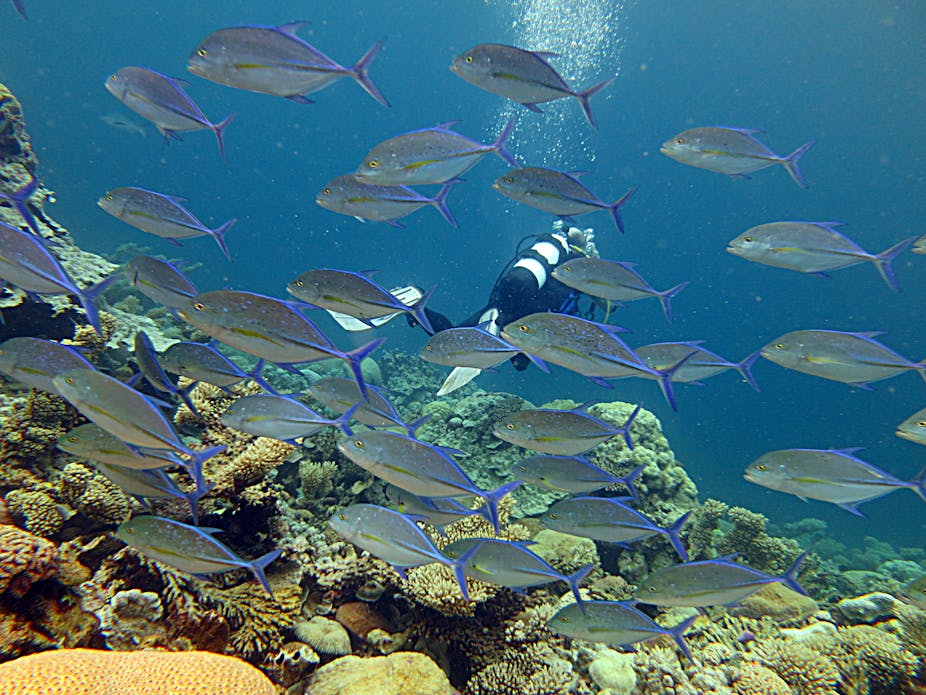The Chagos Islands marine protected area is the largest of its kind in the world, encircling the dozens of tiny islands of the Chagos archipelago that lie in thousands of miles of Indian Ocean between Madagasgar and Asia.
The no-take, complete conservation area that encompasses more than 208,000 square miles of some of the world’s cleanest seas is now teeming with life. A large amount of scientific research in around 200 papers over 15 years has shown that Chagos is biologically a remarkable place.
But the massive wave of coral death that hit the Indian Ocean in 1998 killed most shallow water corals, including those in Chagos. In a distressingly large number of sites, coral life has struggled to recover, or in many places has not significantly recovered at all. All that is left behind are huge rubble fields, of little benefit to humans or to any aspect of biodiversity and conservation.
In contrast, the coral cover in Chagos regained its former presence fairly rapidly. Its fish biomass is now the highest recorded in the world - many times greater than anywhere else in that ocean, including in any other countries’ so-called marine protected areas, which earn the accolade “paper parks”.
On the islands, of which there are about 55 in total, conditions are more mixed. All the larger islands were planted for coconuts 150 years ago, and in so doing the native Indian Ocean hardwood vegetation, with its massive bird, coconut crab and turtle populations, was all but eradicated. Only on some islands which were too small or too difficult for the planters to bother with did these populations survive, and these islands now support huge numbers of seabirds and coconut crabs. Turtles too are recovering in number - all of these are now protected under British Indian Ocean Territory regulations (under which the Chagos fall).
The fact that such striking recovery was possible at all is thought to be largely due to the complete lack of human exploitation. All the inhabitants were removed from all atolls (except Diego Garcia which as a US military base is not part of the marine reserve) following the creation of British Indian Ocean Territory in the early 1970s.
Since then, the rest of the tropical oceans have suffered severe decline, what some have called the “decades of destruction” . The reefs of Chagos, however, as well as various species on land and on its seamounts and other, deeper marine habitats have survived in a way which contrasts strikingly with those atolls and islands with human inhabitants.
Far-reaching local regulations made since the early 1970s that affect both visitors and the military in Diego Garcia, strictly limit exploitation of natural resources. This area is now the closest we might expect to see to a nearly unexploited reef system, and as a result many scientists seek to do research there as a result.
Several of the UK’s largest and most prestigious science societies and NGOs co-ordinated by the Pew Foundation, put a case for maximum protection of the Chagos to the government. And so in 2010 this substantial, if accidental, refuge was consolidated when the area became a fully no-take marine protected area.
One practical addition to existing conservation regulations made by this declaration - the only major practical addition, in fact - was the prohibition of fishing, at the time almost all industrial tuna fishing.
This remarkable marine reserve has been challenged by some partly on the grounds that its creation had other motives, such as keeping Chagossians out. But their displacement happened 40 years ago, when the British Indian Ocean Territory was created - and after much financial difficulty in the remaining plantations, some of which had already collapsed. The creation of the conservation reserve happened just three years ago, so the suggestion it was to keep Chagossians from returning makes no sense.
In fact, it is the scientists engaged in research on the Chagos who are doing the most to work with the Chagossians and their children in the country of their heritage. The Chagos Trust provides funds for a Chagossian to travel back to their ancestral lands with every scientific journey made there.
The recent challenge on behalf of some Chagossians to the legality of this has been dismissed. Any other decision presumably would not have helped Chagossians anyway; if the judge’s verdict had led to abolition of the protected area, perhaps the only result would have been the return of tuna fishing. The tuna industry would love that, but what would it do for the Chagossians, or for the study of this unique, diverse place?

